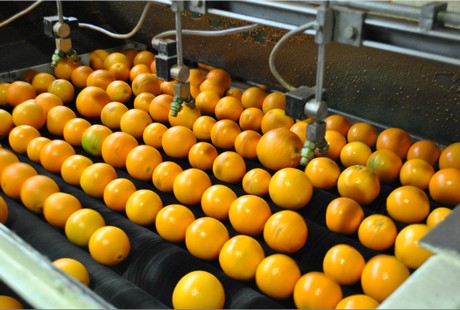 s from South Africa has arrived in the U.S. marking the start of the 15th season for South African Summer Citrus in the U.S. The container vessel MSC Valvik brings 90 tons of Clementines and Navel oranges for the U.S. market hungry for citrus fruits.
s from South Africa has arrived in the U.S. marking the start of the 15th season for South African Summer Citrus in the U.S. The container vessel MSC Valvik brings 90 tons of Clementines and Navel oranges for the U.S. market hungry for citrus fruits.“For a variety of reasons, many weather related, domestic citrus supplies in the U.S. are at more reduced levels than in seasons’ past,” said Ms. Suhanra Conradie, CEO of the Western Cape Citrus Producers Forum (W.C.C.P.F.). “To meet this immediate demand, we expect to send nearly twice as much citrus at this time as compared to initial shipments of 2013.”
Container vessels arrive in the Port of Newark, N.J. and transport approximately 15 percent of the overall volume during the season. Conventional vessels dock at Philadelphia’s Holt Terminal in Gloucester City, N.J., transporting the remaining 85 percent. The first conventional vessel will arrive in late June; three additional container vessels will arrive in the interim. Fresh citrus arrives from South Africa every 10 days from late May through October.
“Easy Peelers better known in the market as Clementines are in high demand in the U.S. and this initial shipment brings more of those than Navels,” said Ms. Conradie. “That will adjust later in the season when the volume of Navels increases. Star Ruby grapefruit and Cara Cara oranges begin arriving in late June.”
Consumer access to the South Africa Summer Citrus will be more rapid in 2014 than in recent years. A pilot program reducing the cold sterilization from 24 to 22 days is underway for the 2014 season. Citrus from South Africa is shipped at a temperature of -0.5’C or 31’F to avoid chemical fumigation on arrival. Science confirms that 22 days is sufficient to assure no pests can arrive with the fruit.
The agreement results from discussions earlier this year with the U.S.D.A.’s Animal & Plant Health Inspection Service (A.P.H.I.S.) and South Africa’s Department of Agriculture, Forestry & Fisheries (D.A.F.F.). Aggressive and consistent efforts by citrus growers have reduced the incidences of false codling moth (FCM) in fruit to less than 0.05 per tree in 2014 as compared to 0.19 in 2013 and 0.48 in 2012.
“The two agencies have been committed to our export program to the U.S. and work bilaterally as well as with the growers to assure compliance,” said Ms. Conradie. “A unique aspect to our program is the citrus is subject to pre-clearance in Cape Town before export to the U.S. where it then undergoes additional inspection on arrival. The reduction by two days means the fruit is available in the marketplace that much faster and will have a longer shelf life once in the market.”
Citrus production for this season is at high levels and will enable greater volumes for the U.S. market. Normal weather conditions to date have enabled harvesting to proceed without interruption. “Weather and climate conditions cannot be underestimated when it comes to the taste and appearance of our fruit,” said Ms. Conradie. “South Africa’s summer heat contributes to the sweet taste followed by colder temperatures which enable the fruit’s color to brighten orange.”
Strong relationships with importers and retailers in the U.S. and close collaboration before and throughout the season assure the preferred sizes and volumes are shipped at the correct market time. “Smaller fruit yields well for the growing popularity of bagged fruit in the U.S. market,” said Ms. Conradie. “In all cases, fruit to the U.S. exceeds the internal quality requirements and is packed to assure it exceeds the strictest of fruit safety regulations.”
The program began in 1999 with 50 tons and has grown to +/- 41,000 tons per year. South African citrus exported to the U.S. is grown primarily in the Western and Northern Cape regions.





